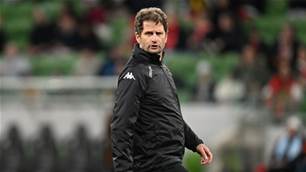Never Say Die by Fiona Crawford and Lee McGowan is a detailed and enjoyable look at the history of women’s football in Australia.
Through exhaustive research and the collection of personal anecdotes it paints a vivid picture of the sport and recognizing the struggles of the past generations it gives the current success context while warning of what can be lost in the future if the game is taken for granted.
Although it is a valuable text on the history of women’s football, it is no dour lesson or encyclopaedia instead containing surprising and delightful tales of ingenuity, misadventure and camaraderie. Without spoiling too much, here is a taste of some of those stories.
Marta Who?
When Australia arrived at the 2011 World Cup, they were a team brimming with confidence after the previous year's victory in the Asian Cup. Young up and comers like Kyah Simon and Emily van Egmond began to show that they belonged at the elite level and Lisa De Vanna confirmed her reputation as one of Australia’s finest players.
When the Matilda’s faced Brazil in the opening game, coach Tom Sermanni entrusted the job of marking Marta to a then 16-year-old Caitlin Foord.
To put this in perspective, the Brazil number 10 had been acknowledged as the best player in the world the previous five years in a row and was at the height of her considerable abilities.
“I knew she was going to be fine because she didn’t really know who Marta was,” Sermanni is quoted as saying, “when I was talking about Marta, she just kind of shrugged her shoulders: 'Ok.'”
Her performance shows that she was far from disrespectful of the legend, but was simply comfortable enough at that level that she was able to contain on of the greatest players of all time with a confidence that could be mistaken like nonchalance.
She was awarded the Young Player of the Tournament and her career since has validated that she had nothing to fear.
Why Does The Grass Have Eyes?
The book gives a portrayal of life on the road for previous Matildas that has until now, been largely undocumented. The under-resourced team rarely had the luxuries that elite athletes should have been provided and busses that had toilets on them should have been a minimum provision for teams asked to travel across the United States.
Never Say Die depicts an incident when the players were forced to pull over and make use of some long grass in lieu of a bathroom, a smart enough idea unless you are aware of some of the predatory wildlife that prowls the U.S.
“Suddenly the players noticed the distinctive glint of Alligator eyes and long snouts emerging from the grass,” writes Crawford. Sometimes sprint training and beep tests can come in handy when you least expect it.
Hotel Hijinks, Hidden Rooms & Homework
Not many of us will ever be as familiar with North Korean hospitality as The Matildas. Crawford and Mcgowan write of accommodation in vast marble towers, with power flickering on and off and the only company being the unsettling noises coming from hidden compartments.
“You could also see the secret doors around the hotel rooms and you could hear people behind the walls,” says Alicia Ferguson-Cook, explaining one of the reasons they had team meetings in the car park.
There are stories of bathtubs being bought at markets in China and carried back to hotels, $5 bags of ice being used to fill them for recovery and showers being turned on to fool officials checking on curfew.
There are details of certain teenaged star players doing their best to avoid homework and others completing Year 12 exams mid-flight.
The highlight would probably be the squad demonstrating well-drilled teamwork to find a way around rapper Snoop Dogg’s security detail to get a group photo with the hip-hop star.
There are many other stories, involving a bet to dye the head coach’s hair during a major tournament, a ride hitched on a Russian cargo jet, the usually publicity-shy Lisa De Vanna requiring a police escort to leave a stadium while being swarmed by fans and Jenna Drummond meeting her husband as a result of the unprecedented W-League marketing campaign.
Beyond these tales, Never Say Die is a detailed telling of the rich history of women’s football in Australia, from the game’s pioneers in the 20’s to the superstars at major European clubs today and the hidden figures that make it all possible, this is essential reading for football fans.
Related Articles

'Timing not right': Montemurro's verdict on Matildas vacancy

Matildas: 'Fourth at the Olympics is honestly the worst place you could come'
.jpg&h=172&w=306&c=1&s=1)












